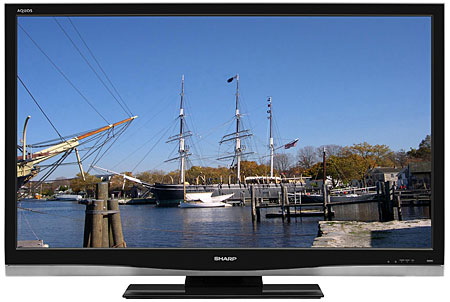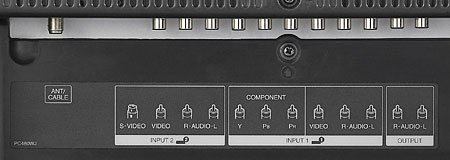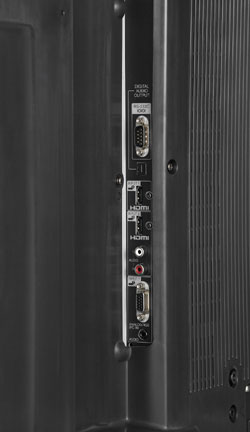Sharp AQUOS LC-52D64U 52" LCD Digital Television

That doesn't mean that the company can rest on its laurels. The competition is intense, with old players making serious inroads, and new players popping up around every corner. It's an international race. Ever heard of Funai or Daewoo? If not, you might soon.
Sharp's latest sets are in the 64U series, coming in three sizes: 42, 46, 52 and 65 inches. The LC-52D64U ($3,499), like the others, has as its main selling point an ultra thin depth of just 3.75" (without stand). But there's more to the story here than a Slim-Fast diet.
Description
The newest Sharp looks very much like the company's other recent designs, with a relatively thin, shiny black frame on three sides and a thicker bottom piece with a melted looking droop in the middle. The Sharp's audio comes from a narrow perforated aluminum strip just below that. The sound (which I'll not cover further in this review) is surprisingly good considering the space it comes from—hardly serious home theater quality, but perfectly listenable for casual use.
There are seven numbered inputs plus TV, the latter for the set's onboard NTSC and ATSC tuners. There is no CableCARD slot, a common omission in many new sets.
The inputs are configured in a rather unusual way. On the back, Input 1 offers either a composite or component YPbPr connection, while Input 2 offers composite or S-Video. Both Inputs 1 and 2 have analog L/R audio jacks. Inputs 5 and 6 include HDMI and Input 6 also has separate L/R analog audio connections should they be needed—using the HDMI connection with a DVI source, for example. Input 7, on a VGA (15-pin D-Sub) connector plus a separate audio mini jack, is for a PC. Other rear panel connections include a single RF antenna input, two audio outputs (TosLink digital and L/R analog) and an RS-232 connector.
On the right side of the set are two other inputs: Input 3 (component or composite, plus L/R audio) and Input 4 (HDMI). There is also a USB port on the side panel for software updates. Overall, that's a more flexible set of side inputs than most TVs, and a real plus in a flat panel, particularly if it's wall-mounted. The set's controls are also just above this side panel.
While the inputs are labeled generically as simply Video 1-7, you can rename them using one of several preset names, such as DVD and VCR, selectable from a separate menu. Interestingly, in my case the set automatically recognized my cable box and changed that input to read Explorer 8300—a name not on the menu.
The Sharp offers all of the typical features: multiple aspect ratios (Sharp calls this View Mode), a (code) programmable remote, Parental control via a V-Chip, and the usual video adjustments.

Another increasingly common feature is the HDMI CEC (Consumer Electronics Control) protocol. It's designed to operate compatible equipment through the set's remote control using the HDMI links between the components in the system. Most manufacturers have come up with their own creative, proprietary names for it; Sharp calls it AQUOS Link. I did not test it in this review.
Conspicuous by absence are PIP and/or POP. For some consumers this may be significant. For others, like me, it isn't.
The LC-52D64U does not operate at 120Hz. Currently only Sharp's F92 and D82 series offer this feature. And the set will not accept 24fps video. Sharp informs us that a running change enabling 24Hz compatibility is scheduled to start in units manufactured from December forward. No word on whether existing units will be updated.
 Video Adjustments
Video Adjustments
Apart from the usual adjustments (Brightness, Color, Tint, Contrast, Sharpness), the LC-52D64U, as with most current sets, has its own lineup of special adjustments. They are, for the most part, less intimidating than those offered by some manufacturers.
There are eight AV modes: Standard, Movie, Game, PC, xvYCC, User, Dynamic Fixed, and Dynamic. While you can adjust each of these modes individually (except Dynamic Fixed), only User may be set separately for each input. I used Movie mode, with changes from the factory settings, for virtually all of my serious viewing and testing. The xvYCC mode did not appear on my set, suggesting that it cannot be selected unless it "sees" an xvYCC source, which, to our knowledge, is limited to a few HD camcorders.
Of the five Color Temperature settings, Low produced the most accurate results. Fortunately, it was quite close to the D6500 standard (see "Measurements"). Calibration could have improved it slightly, but calibration was not possible. As with other recent Sharp sets we have reviewed, calibration can only be done using proprietary computer software at the factory. According to Sharp, however, field-adjustable calibration controls should begin to show up on its new models coming in 2008.
As with many recent LCD sets, the Sharp lets you adjust the intensity of the panel's Cold Cathode Fluorescent Lamp (CCFL) backlight. There is also a feature called OPC, which senses the ambient light in the room and changes the backlight level automatically to compensate. And yet another option lets you choose the minimum and maximum range of the backlight when OPC is selected. I preferred to set the backlight manually and did not use the OPC.
I left most of the other special features off. Active Contrast did enhance the black level, but it sometimes degraded the image as well. Fine Motion did help reduce image blur with some program material, but it wasn't always a plus. I'll have more to say about these two controls a bit further on, since they interacted in unusual ways with each other and with the Brightness control, which sometimes made choosing the best settings a tricky balancing act.
The I/P control is also supposedly intended to optimize the display for either fast moving or slow moving images, and has two settings: Fast and Slow. It's available only with progressive inputs, and it had a far more subtle effect than the Fine Motion control when it had any visible effect at all. I set it to Slow and left it there.
- Log in or register to post comments























































